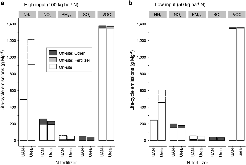Life cycle air quality impacts on human health from potential switchgrass production in the United States
Abstract
Switchgrass is a promising bioenergy feedstock, but industrial-scale production may lead to negative environmental effects. This study considers one such potential consequence: the life cycle monetized damages to human health from air pollution. We estimate increases in mortality from long-term exposure to fine particulate matter (PM2.5), which is emitted directly (“primary PM2.5”) and forms in the atmosphere (“secondary PM2.5”) from precursors of nitrogen oxides (NOx), sulfur oxides (SOx), ammonia (NH3), and volatile organic compounds (VOCs). Changes in atmospheric concentrations of PM2.5 (primary + secondary) from on-site production and supporting supply chain activities are considered at 2694 locations (counties in the Central and Eastern US), for two biomass yields (9 and 20 Mg ha–1), three nitrogen fertilizer rates (50, 100, and 150 kg ha–1), and two nitrogen fertilizer types (urea and urea ammonium nitrate). Results indicate that on-site processes dominate life-cycle emissions of NH3,NOx, primary PM2.5, and VOCs, whereas SOx is primarily emitted in upstream supply chain processes. Total air quality impacts of switchgrass production, which are dominated by NH3 emissions from fertilizer application, range widely depending on location, from 2 to 553 $ Mg–1 (mean: 45) of dry switchgrass at a biomass yield of 20 Mg ha–1 and fertilizer applicationmore »
- Authors:
- Publication Date:
- Research Org.:
- Univ. of Minnesota, Minneapolis, MN (United States)
- Sponsoring Org.:
- USDOE
- OSTI Identifier:
- 1410139
- Alternate Identifier(s):
- OSTI ID: 1504241
- Grant/Contract Number:
- EE0004397
- Resource Type:
- Published Article
- Journal Name:
- Biomass and Bioenergy
- Additional Journal Information:
- Journal Name: Biomass and Bioenergy Journal Volume: 114 Journal Issue: C; Journal ID: ISSN 0961-9534
- Publisher:
- Elsevier
- Country of Publication:
- United Kingdom
- Language:
- English
- Subject:
- 54 ENVIRONMENTAL SCIENCES; Ammonia; Bioenergy; Ecosystem services; Fertilizer; Particulate matter; Switchgrass
Citation Formats
Thakrar, Sumil K., Goodkind, Andrew L., Tessum, Christopher W., Marshall, Julian D., and Hill, Jason D. Life cycle air quality impacts on human health from potential switchgrass production in the United States. United Kingdom: N. p., 2018.
Web. doi:10.1016/j.biombioe.2017.10.031.
Thakrar, Sumil K., Goodkind, Andrew L., Tessum, Christopher W., Marshall, Julian D., & Hill, Jason D. Life cycle air quality impacts on human health from potential switchgrass production in the United States. United Kingdom. https://doi.org/10.1016/j.biombioe.2017.10.031
Thakrar, Sumil K., Goodkind, Andrew L., Tessum, Christopher W., Marshall, Julian D., and Hill, Jason D. Sun .
"Life cycle air quality impacts on human health from potential switchgrass production in the United States". United Kingdom. https://doi.org/10.1016/j.biombioe.2017.10.031.
@article{osti_1410139,
title = {Life cycle air quality impacts on human health from potential switchgrass production in the United States},
author = {Thakrar, Sumil K. and Goodkind, Andrew L. and Tessum, Christopher W. and Marshall, Julian D. and Hill, Jason D.},
abstractNote = {Switchgrass is a promising bioenergy feedstock, but industrial-scale production may lead to negative environmental effects. This study considers one such potential consequence: the life cycle monetized damages to human health from air pollution. We estimate increases in mortality from long-term exposure to fine particulate matter (PM2.5), which is emitted directly (“primary PM2.5”) and forms in the atmosphere (“secondary PM2.5”) from precursors of nitrogen oxides (NOx), sulfur oxides (SOx), ammonia (NH3), and volatile organic compounds (VOCs). Changes in atmospheric concentrations of PM2.5 (primary + secondary) from on-site production and supporting supply chain activities are considered at 2694 locations (counties in the Central and Eastern US), for two biomass yields (9 and 20 Mg ha–1), three nitrogen fertilizer rates (50, 100, and 150 kg ha–1), and two nitrogen fertilizer types (urea and urea ammonium nitrate). Results indicate that on-site processes dominate life-cycle emissions of NH3,NOx, primary PM2.5, and VOCs, whereas SOx is primarily emitted in upstream supply chain processes. Total air quality impacts of switchgrass production, which are dominated by NH3 emissions from fertilizer application, range widely depending on location, from 2 to 553 $ Mg–1 (mean: 45) of dry switchgrass at a biomass yield of 20 Mg ha–1 and fertilizer application of 100 kg ha–1 N applied as urea. Switching to urea ammonium nitrate solution lowers damages to 2 to 329 $ Mg–1 (mean: 28). This work points to human health damage from air pollution as a potentially large social cost from switchgrass production and suggests means of mitigating that impact via strategic geographical deployment and management. Moreover, by distinguishing the origin of atmospheric emissions, this paper advances the current emerging literature on ecosystem services and disservices from agricultural and bioenergy systems.},
doi = {10.1016/j.biombioe.2017.10.031},
journal = {Biomass and Bioenergy},
number = C,
volume = 114,
place = {United Kingdom},
year = {Sun Jul 01 00:00:00 EDT 2018},
month = {Sun Jul 01 00:00:00 EDT 2018}
}
https://doi.org/10.1016/j.biombioe.2017.10.031
Web of Science
Figures / Tables:
 Fig. 1: Life cycle emissions inventory for switchgrass production for two scenarios (a) high input (yield 20 Mg ha−1, N fertilization rate 100 kg ha−1 N) and (b) low input (yield 20 Mg ha−1, fertilization rate 50 kg ha−1 N). Note: “Off-site: Fertilizer” refers to the production of sulfuric acid,more »
Fig. 1: Life cycle emissions inventory for switchgrass production for two scenarios (a) high input (yield 20 Mg ha−1, N fertilization rate 100 kg ha−1 N) and (b) low input (yield 20 Mg ha−1, fertilization rate 50 kg ha−1 N). Note: “Off-site: Fertilizer” refers to the production of sulfuric acid,more »
Works referencing / citing this record:
Air-quality-related health damages of maize
journal, April 2019
- Hill, Jason; Goodkind, Andrew; Tessum, Christopher
- Nature Sustainability, Vol. 2, Issue 5
Figures / Tables found in this record:

 Search WorldCat to find libraries that may hold this journal
Search WorldCat to find libraries that may hold this journal